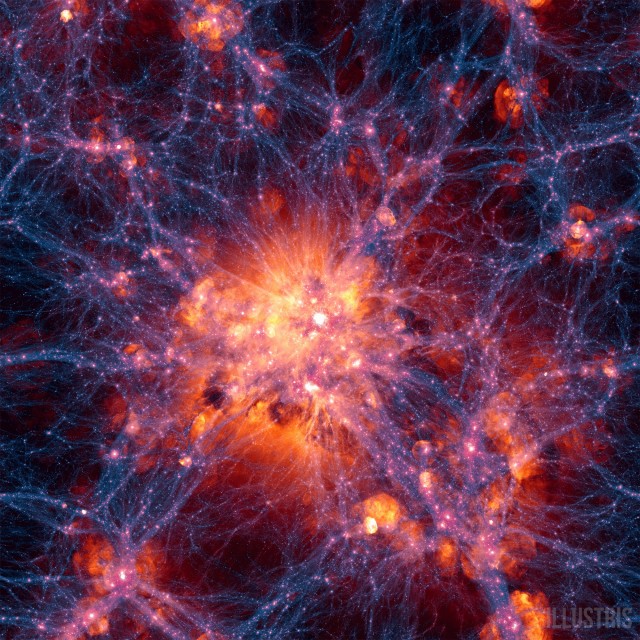Simulation shows that dark energy and matter can reproduce the Universe
Takes 350 million light years of space from 12 million to 12 billion years old.

Gas clusters around a nexus of dark matter filaments within the new simulation.
Illustris
To the best of our ability to tell, the Universe is being shaped by things we can't directly detect: dark matter and dark energy. That makes it somewhat challenging to determine if our understanding of these influences is roughly correct. It's simply hard to be confident that we haven't missed some other dark entity that's lurking beyond our abilities of detection.
One of the ways we can have some confidence that we're not missing anything major is to run models of the Universe. If we've got the basic physics right, then you should be able to set these models loose at an early point in the Universe's history and end up with something that looks like the Universe we're living in.
In general, these models have been remarkably successful, producing a cosmic web of dark matter with clusters of galaxies at the points where the web's filaments intersect. But enough of the details have been wrong in these models that they raise a difficult question: is there something wrong with our understanding, or have we simply run up against the computational limits on what we can simulate?
A new simulation of the Universe argues strongly that we can blame the computers (or, more precisely, our lack of computational power.) By increasing the size and resolution of the modeled Universe, a team has been able to reproduce many more details of the actual Universe's history.
The approach uses what is called a hydrodynamic simulation, one that treats the contents of the Universe as particles of a fluid. The physics controlling the behavior of these particles is that of the Λ-CDM model, in which Λ represents dark energy and CDM stands for cold dark matter. With a handful of parameters set to the values we've measured them to be (there are only six free parameters used in this model), the simulation was set to go.
The big difference in this attempt is simply the scale of things. The slice of the Universe that the researchers modeled was a cube with each side extending over 350 million light years For scale, the nearest galaxy is only 2.5 million light years away; the simulation space ultimately produced 41,416 individual galaxies. The minimum mass of the particles was about a million times the mass of the Sun and as small as 40 parsecs across. Thus, each particle represents multiple stars and/or large volumes of gas. But the behavior of these chunks of matter was based on what we know about star formation and evolution.
In other words, once the gas had sufficient density, stars would start forming within a given chunk of Universe. Once those stars began to explode, the metal content of the chunk would go up, which would influence further star formation and possibly influence neighboring chunks.
This huge cube of Universe was set up with the conditions that prevailed at 12 million years after the Big Bang, and it ran through to the present, roughly 13 billion years later.
A massive elliptical galaxy forms by the merger of smaller galaxies within the simulation. (left: visible light; right: gas density)
The results were then compared to observational data. At early stages, the galaxies that formed looked indistinguishable from what we see in the Hubble Deep Field image. At later stages, galaxies naturally formed into the spirals and ellipses that we see around us. This later is a rather significant point, since earlier simulations hadn't managed this successfully. The distribution of metals and unionized hydrogen also matched up nicely with observations.
In fact, so many things lined up with observations that the authors consider the model to be strong support for our understanding of the Universe: "Previous futile attempts to achieve this [accuracy] were not due to an inherent flaw of the ΛCDM paradigm, but rather due to limitations of numerical algorithms and physical modeling."
However, the model didn't perfectly reproduce our Universe; low mass galaxies in the simulation started forming stars early and at an elevated rate, so they look much older than the ones we have in our Universe. There's still some work to be done on a few details. But like any good model, this one also makes some predictions about the distribution of hydrogen and metals that we can test against observations.
Overall, it's an impressive bit of work, likely setting the standard for a number of years to come. Inevitably, however, hardware will march on and we'll get even more refinements in our understanding of the Universe's evolution. Either that, or some hints of another dark something-or-other will turn up in observations and force the modelers to do a major rethink.

No hay comentarios:
Publicar un comentario